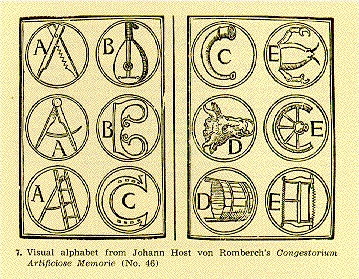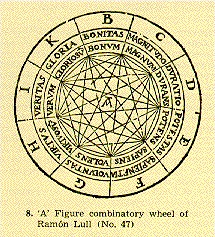Memory & Mnemonics
JOHANN HOST VON ROMBERCH (fl. 1485-1532)
Congestorium Artificiose Memorie.
Venice, Melchiorre Sessa, 1533
Originally published in 1520, Host von Romberch's work draws on a wide variety of sources, including the Rhetorica ad Herennium, Quintilian, Francesco Petrarch (1304-1374), and Peter of Ravenna (b. 1448). He gives to the usual use of memoryloci (mental places for storing data) a novel twist, that of employing Dante's Hell, Purgatory, and Paradise. In discussing mental images or symbols of information to be recalled, he offers the reader a section on visual alphabets, in which the images used resemble the shape of letters. The final portion of Congestorium deals with the memorization of grammar and of abstract concepts from the sciences and theology. This portion has been much influenced by Thomas Aquinas (1225?-1274). (BMC Italian books p. 335; NUC 255:600 (NH 0537275); Young p. 164)
RAMON LULL (d. 1315)
Opera.
Strassburg, Lazer Zetzner, 1609.
A contemporary of Thomas Aquinas, Lull developed his memory system at a time when the mediaeval mneumonic techniques derived from rhetoric were at their height. Up to his time, mneumonics aimed solely at facilitating the immediate recall of data. Lull introduced a new dimension by making his Art, as he called it, a means to an end, the discovery of truth. This was possible, he claimed, because his Art was based upon the divine attributes (goodness, wisdom, and the like) and thus reflected the highest truth, the Trinity. Another feature of his system is the use of letter notation rather than corporeal images, then customary in memory systems, to designate concepts. Finally, Lull introduced the use of movement into mneumonics. The most important instance of this is the combinatory wheel, made up of moving concentric circles marked with figures. By revolving the wheels mentally, various combinations of the concepts represented by the figures were possible.
This edition of Lull's works includes a commentary by Heinrich Cornelius Agrippa von Nettesheim (1486?-1535), better known for his work on Hermetic and cabalist magic, De Occulta Philosophia(Paris, 1531). Appended also is a piece on Lull by Giordano Bruno (1548-1600), whose work on memory as a Hermetic secret, De Umbris Idearum (Paris, 1582), freely adopts Lull's combinatory wheel technique. (Bibliothèque Nationale CI:831; Young p. 217)
JACOPO PUBLICO (15th cent.)
Ars Oratoria. Ars Epistolandi supra Scriptones Epistolarum. Et Ars Memorativa.
Augsburg, Erhard Ratdolt, 1490
A work written sometime prior to 1460, the Ars Oratoria is primarily a piece on rhetoric. Faithful to mediaeval tradition, it has appended to it a brief treatise on memory. Following the methods of mnemonist as corporeal similitudes of the items to be remembered. Publicius uses the heavenly spheres -- planets, stars, paradise -- as memory loci. First published separately at Cologne in 1480, Ars Memorativa is the earliest printed treatise on memory. (BMC 15th cent. II:384 (IA 6700); Galland p. 151; Polain (B) 3278; Young p. 171)
RHETORICA AD HERENNIUM
M. T. Ciceronis Rhetoricorum Libri recenter Castigati Interpretibus.
Milan, Giovanni Angelo Scinzenzeler, 1511
This anonymous work, written ca. 86-82 B. C., is the only surviving Latin rhetorical treatise describing in detail the classical art of memory. It was attributed to Marcus Tullius Cicero during the Renaissance, but this attribution is highly unlikely. With the exception of Lullism, the Ad Herenniumformed the basis of all memory systems developed during the middle ages. The author's mnemonic system involves the use of loci, such as buildings, in which the mind puts symbolic pictures, or images, of data to be remembered. To recollect material, the person would mentally walk through the memory building and "see" the items to be recalled. Edited by Freancesco Maturanzio (d. 1518) and others, the volume includes a genuine work of Cicero, De Inventione, often printed or bound with the Ad Herennium.
This volume, in a contempory vellum binding, is clearly a composite, dating from 1511. Differing types are used for the Ad Herennium and De Inventione. The foliation, although continuous, is an Arabic and Roman numerals respectively for each work. The title page bears a woodcut like that in several Leonard Pachel issues of the Ad Herennium. The register on the verso of the last leaf of the volume includes only the De Inventione. Below this register there is the printer's mark of Giovanni Angelo Scinzenzeler. Apparently Scinzenzeler has taken excess signatures of the Ad Herennium from the 1411 Pachel edition of both works, and bound them with his own printing of Scinzenzeler's own complete printing of the two works appeared in 1512. No other copies of this composite issue are known. The following citations have reference only to complete editions of the two works appearing in 1509, 1511,and 1512. (Balsamo 105; Bibliothéque Nationale XXIX:290 (no. 2684); BMC 39:600; Orelli OT I:219-220; Panzer XI:462)
COSMAS ROSSELLIUS (d. 1578)
Thesavrvs Artificiosae Memoriae.
Venice, Antonio Padovani, 1579.
Published posthumously, Thesaurus is in the mediaeval tradition of memory systems. Particularly favorable to the Dantesque type of memory loci, Rossellius encourages the mnemonist to picture in his mind Hell and Paradise with the vividness of a Renaissance painting. He also advoates the use of the constellations as loci. The usual visual alphabet is given extensive treatment. In this context Rossellius describes a digital alphabet, or sign manual, for the fingers. Accompanying the description are five woodcuts containing the earliest known representation of a digital sign language. Together with Host von Romberch, Rossellius became one of the most widely read and influential writers of the sixteenth century on the art of memory. (Adams R803; BMC Italian books p. 588; Young p. 307)
JOHN WILLIS (d. 1628?)
Mnemonica; sive, Reminiscendi Ars.
London, Nathaniel Browne, 1618.
Mnemonica is interesting chiefly because of its use of the Elizabethan theater as a memory locus. Dividing a theater in half, lengthwise, Willis produces what he terms a memory repository having two rooms, designed for very simple mnemotechnic, such as shopping lists or prices. The importance of Willis' work lies in its probable influence on Robert Fludd (1574-1637). In the second part of hisUtriusque Cosmoi Maioris scilicet et Minoris, Metaphysica, Physica atque Technica Historia(Oppenheim, 1619), Fludd develops this use of the theater as a memory locus along Hermetic-cabalist lines. Frances Yates points out that Fludd uses as his model locus the famous Globe Theater in London. Willis may also be the inspiration behid Fludd's theaters of Night and Day in the zodiac, parts of an occult memory system. Mnemonica was translated into English by Leonard Sowersby in 1661. (Carlton (Pepys) p. 21; Galland p. 203; STC 25748; Young p. 378)

